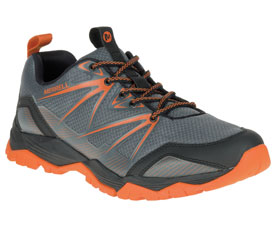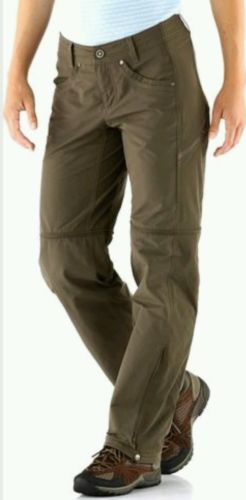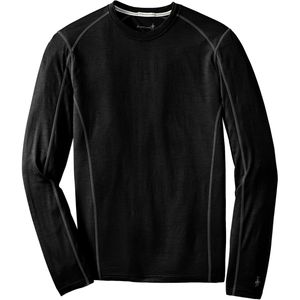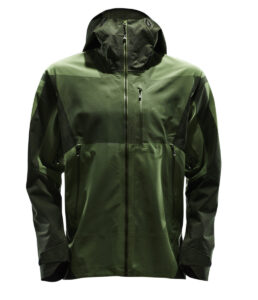Life is a series of transitions, of starting with the basics, then, as your needs and tastes mature, trading up. Hiking, being a part of life, is the same way. We start with what we have on hand — running shoes, jeans, sweatshirt, gimme-drawstring bag — then move into the gear that will improve our performance, make us more comfortable, make hiking even more enjoyable.
Here are some of the key trade-ups new hikers face, with tips on what to look for.

Shoes/boots. Those running shoes/sneakers will do you well for a mile or so on the trail. But after a while, the skimpy soles will give you sore feet, the lack of support will result in one-too-many ankle twists. And should you encounter wetness — from a soggy, post-rain path to a lone puddle — they’ll embrace the wet and won’t let it go. For longer hikes, the main thing you want in a hiking shoe or boot is comfort. Come into the shop, try on as many shoes/boots as you like, walk around the store. Like any relationship, it’s impossible to tell how you’ll get along in the long-run. But if they make you happy initially, run with your first impression. Check the lacing to make sure the system gets the shoe snug but doesn’t create pressure points. Check the tread on the bottom of the shoe to make sure it’s compatible with the trail surface you hike most: fans of rockier trails, for instance, will want a grippier bottom. Is it waterproof? That’s generally a good thing, especially in the Southeast, where a dewy early-morning trail can soak your shoes in a matter of steps. Shoes or boots? Depends in part on personal preference, in part on how much support your ankles need. Above all else, try not to look at the price tag when trying on shoes: more than any other gear, shoes have the power to make or break your hike. Spend accordingly.
Find a suggestion here.

Pants. Amazing how many people continue hiking in jeans, even after they start tackling longer, more challenging trails. You know the industry catch phrase “Cotton is King?” It’s true — until you get caught in a cold rain and discover the truth that doesn’t appear in their advertising: cotton kills. Cotton absorbs wet, stays wet. Thus, when shopping for hiking pants the first thing to look for is a nice synthetic blend, with maybe a little polyster, a little nylon, perhaps some spandex. You want pants that protect you from the wind, but also breathe a bit to keep your legs from sweating. You also want convertible pants; that is, pants that zip off above the knee to become shorts. There’s the obvious advantage of having pants and shorts rolled into one. But they’re mighty handy on those warm weather hikes where you suddenly find yourself navigating tight brush that could be harboring stinging nettles, poison ivy or oak, and any number of jabby vines. And don’t overlook the pockets! Think about the things you like to have handy on a hike — map, snacks, a camera/camera phone, knife — and make sure your new pants have pockets to accommodate these essentials. As for cost, you should be able to find good convertible hiking pants in the $60 to $80 range.
Find a suggestion here.

Shirt. For summer hiking in hot weather, we waive the no-cotton rule: damp cotton against your skin works as cheap air conditioning. For cooler weather, and in higher altitudes where the temperature can change radically, we’re big fans of merino wool. Merino wool is soft against the skin, it breathes, it dries quickly, it takes a lot to make it smell. It’s also expensive: you can expect to pay around $50 for a shirtsleeve merino wool shirt, $80 and up for long sleeve, depending upon the weight of the wool.
Find a suggestion here.

Fleece layer. When the weather cools, you’ll want a lightweight fleece layer to throw on. Pullovers with a zip neck are preferred (a full-length zipper lets cool air sneak in). Cinched wrist cuffs and waistbands are good, letting you retain valuable body heat. For hiking in the Southeast, a lightweight fleece — or micro fleece — should suffice (again, fleece does a good job of helping you maintain and retain body heat). Zippered pockets are preferred, providing a convenient place to stick your gloves and hat (and perhaps another snack).
Find a suggestion here.
Shell. Ah, the shell, an invaluable piece of clothing under very specific circumstances: when the temperature is between about 35 and 50, and it’s raining. Under these circumstances, the typical shell will indeed keep you warm and dry. If it gets much colder, make sure you’re wearing the aforementioned fleece layer. If it gets much warmer, you’re likely to get wetter from sweat build-up (sorry, there’s no delicate way to put it) than from the rain. The trouble? Vaunted “waterproof” technologies aren’t quite where they need to be. They claim to breathe while at the same time keeping rain out, and some are close. But we aren’t there yet. They’re good for winter hikes in wet (or windy) weather; for staying dry in summer you’re better off with a cheap poncho.
Find a suggestion here.

Daypack. We could go on and on (and on and on) about the virtues of the daypack. We’ll keep it succinct with a few quick tips. Waist belt: Even if you don’t plan on carrying heavy loads, a substantial waist belt is essential to bear the weight of your load. Ditto lightly padded shoulder straps, which won’t rub your shoulders raw. Hydration bladder friendly: If your pack doesn’t come with a hydration bladder, make sure it will at least accommodate one. With a bladder, water is always at the ready, and nothing can torpedo an outing like getting dehydrated. Pockets: Found a pack you like? Check its pocket situation. First, it must have pockets on the hip belt, where you can access, on the move, snacks (yes, more snacks!) and other vitals. If you use water bottles, make sure you can access the bottle from its holster pocket(s) with the pack on as well as easily put the bottle back. If the pack passes these tests, take your list of 10 Daypack Essentials and determine where everything will go. Happy? You’ve got a pack, my friend! You can find a doable daypack for as little as $60 (watching for sales); one that will make you a very happy hiker will run closer to $100 (or more).
Find a suggestion here.
